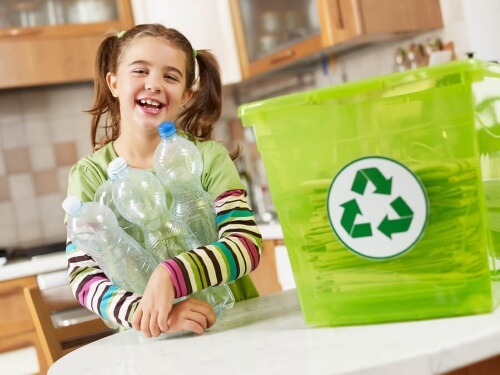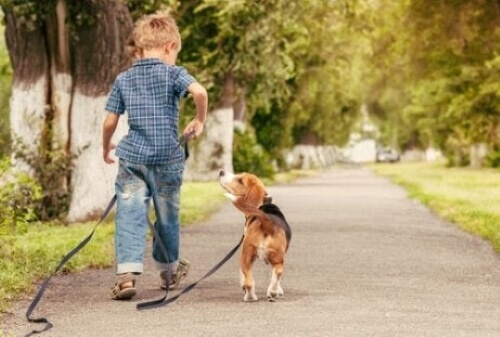Teaching Children to Be Environmentally Aware

Awakening a child’s environmental awareness implies teaching them to care about the environment and respect all living things. Teaching a love of nature to young children makes them more conscious of the impact they have on their surroundings. By teaching children to be environmentally aware, they learn to treat the planet in a responsible way.
There are many ways to become more aware of our environmental impact using simple concepts like reducing consumption, reusing, and recycling. Developing profound empathy towards living things while young helps children to assimilate more sustainable ideas about the environment when they’re older.
The many ways we’re dependent on nature
There are different paths you can follow when thinking about nature. First, if you reflect on your immediate surroundings, there are many things that come from nature if you also consider the materials they’re made from. It seems overwhelming at first for children and adults alike to accept that absolutely everything is derived from nature.
For example, the children might stop to think about a plastic toy, but it has natural elements because it’s made from petroleum – a substance that’s extracted from the earth and used as a scarce and non-renewable source of energy.
Another case are books that can empty the forests of trees. Wood is extracted from forests that will later serve as the paper children use for their drawings.
Many of the products that children use every day come from nature, including the cotton inside their stuffed animals. Even the bricks used to build homes are made from substances like clay, sand, and concrete that are extracted from the earth.
Something that seems so abstract like the word “nature” becomes more tangible when the children can identify objects in their surroundings. They can visualize how things are derived from nature and how they’re also dependent on it.
One way to help children assimilate this idea is by asking them about their favorite toy. Have them think about the toy and try to identify the material it’s made from.
For a child, understanding the origins of an object will give the toy new meaning. This kind of exercise can become a seed that helps them become more environmentally aware eventually.

Teaching children to be environmentally aware: natural resources
For environmental awareness among young children, it suffices that they learn to respect nature in general and understand why they should exercise responsible consumption. Beginning at about 10 or 12 years old, children are capable of understanding that natural resources are finite.
In addition, you can sensitize children to the selection of certain products that are better for the environment. It’s also possible to ask them to reflect on the role that big factories play in abusing the planet.
Also, it’s good they learn about the dangers in the use of agrochemicals. They should also learn how it’s necessary to respect biodiversity.
Nature needs to recover from the contamination that big cities, mining companies, paper mills, and other big offenders have caused.
How can you encourage environmental awareness in your home or classroom? All the simple solutions seem like grains of sand compared to the big problem of environmental pollution.
Awakening environmental awareness: 10 options for change
In honor of World Environment Day, the World Association of Early Childhood Educators (WAECE) developed a list of 10 rules for educators to follow so that children learn to take care of the health of the planet:
- Turn off the tap: Saving water is the first rule to teach children to take care of the environment. You should avoid wasting water while brushing your teeth or taking a bath, for example.
- Don’t litter: Another simple, everyday rule is to keep the streets free of litter.
- Share toys: There are other ways to teach the idea not to consume more than necessary. Furthermore, this practice encourages solidarity and empathy for others.
- Recycle: Recycling is key in this list of rules. The idea is to have separate waste bins for organic materials and recyclables. You can also recycle things at home, like plastic bottles and cardboard boxes.
“For environmental awareness among young children, it suffices that they learn to respect nature in general and understand why they should exercise responsible consumption.”
Teaching children to be environmentally aware: Plants, pets, and recycling
- Taking care of plants: Children tend to grab leaves and flowers by impulse, causing damage to plants. The respect for all forms of life is essential for making children more environmentally aware from an early age.
- Turning off the lights: Simply, if you leave an empty room there is no need to keep it lit. On the other hand, looking for natural light to do daily chores improves mood by a number of decibels.
- Taking care of pets: In the case of having pets, it’s healthy for children to learn from a young age how to take care of them. The daily responsibility of living with another species generates conscientiousness and empathy.

- Respect people: Our personalities, cultures, and beliefs are all different and that also needs to be respected. Nobody should impose their own way of thinking over others.
- Reuse paper: Drawing on both sides of a sheet of paper is an example of using paper more economically.
- Take care of what belongs to everyone: The forests, squares, public property, and rivers and lakes belong to everyone and no one. We have to be respectful with what we use and don’t use.
Ultimately, encouraging environmental awareness in children also involves taking them to visit a farm, doing some gardening, or simply spending time in the countryside.
You have to expose them to all the possibilities. Allow them to ask questions and experiment. Above all, you should help them find their own way to take care of and respect the planet.
Awakening a child’s environmental awareness implies teaching them to care about the environment and respect all living things. Teaching a love of nature to young children makes them more conscious of the impact they have on their surroundings. By teaching children to be environmentally aware, they learn to treat the planet in a responsible way.
There are many ways to become more aware of our environmental impact using simple concepts like reducing consumption, reusing, and recycling. Developing profound empathy towards living things while young helps children to assimilate more sustainable ideas about the environment when they’re older.
The many ways we’re dependent on nature
There are different paths you can follow when thinking about nature. First, if you reflect on your immediate surroundings, there are many things that come from nature if you also consider the materials they’re made from. It seems overwhelming at first for children and adults alike to accept that absolutely everything is derived from nature.
For example, the children might stop to think about a plastic toy, but it has natural elements because it’s made from petroleum – a substance that’s extracted from the earth and used as a scarce and non-renewable source of energy.
Another case are books that can empty the forests of trees. Wood is extracted from forests that will later serve as the paper children use for their drawings.
Many of the products that children use every day come from nature, including the cotton inside their stuffed animals. Even the bricks used to build homes are made from substances like clay, sand, and concrete that are extracted from the earth.
Something that seems so abstract like the word “nature” becomes more tangible when the children can identify objects in their surroundings. They can visualize how things are derived from nature and how they’re also dependent on it.
One way to help children assimilate this idea is by asking them about their favorite toy. Have them think about the toy and try to identify the material it’s made from.
For a child, understanding the origins of an object will give the toy new meaning. This kind of exercise can become a seed that helps them become more environmentally aware eventually.

Teaching children to be environmentally aware: natural resources
For environmental awareness among young children, it suffices that they learn to respect nature in general and understand why they should exercise responsible consumption. Beginning at about 10 or 12 years old, children are capable of understanding that natural resources are finite.
In addition, you can sensitize children to the selection of certain products that are better for the environment. It’s also possible to ask them to reflect on the role that big factories play in abusing the planet.
Also, it’s good they learn about the dangers in the use of agrochemicals. They should also learn how it’s necessary to respect biodiversity.
Nature needs to recover from the contamination that big cities, mining companies, paper mills, and other big offenders have caused.
How can you encourage environmental awareness in your home or classroom? All the simple solutions seem like grains of sand compared to the big problem of environmental pollution.
Awakening environmental awareness: 10 options for change
In honor of World Environment Day, the World Association of Early Childhood Educators (WAECE) developed a list of 10 rules for educators to follow so that children learn to take care of the health of the planet:
- Turn off the tap: Saving water is the first rule to teach children to take care of the environment. You should avoid wasting water while brushing your teeth or taking a bath, for example.
- Don’t litter: Another simple, everyday rule is to keep the streets free of litter.
- Share toys: There are other ways to teach the idea not to consume more than necessary. Furthermore, this practice encourages solidarity and empathy for others.
- Recycle: Recycling is key in this list of rules. The idea is to have separate waste bins for organic materials and recyclables. You can also recycle things at home, like plastic bottles and cardboard boxes.
“For environmental awareness among young children, it suffices that they learn to respect nature in general and understand why they should exercise responsible consumption.”
Teaching children to be environmentally aware: Plants, pets, and recycling
- Taking care of plants: Children tend to grab leaves and flowers by impulse, causing damage to plants. The respect for all forms of life is essential for making children more environmentally aware from an early age.
- Turning off the lights: Simply, if you leave an empty room there is no need to keep it lit. On the other hand, looking for natural light to do daily chores improves mood by a number of decibels.
- Taking care of pets: In the case of having pets, it’s healthy for children to learn from a young age how to take care of them. The daily responsibility of living with another species generates conscientiousness and empathy.

- Respect people: Our personalities, cultures, and beliefs are all different and that also needs to be respected. Nobody should impose their own way of thinking over others.
- Reuse paper: Drawing on both sides of a sheet of paper is an example of using paper more economically.
- Take care of what belongs to everyone: The forests, squares, public property, and rivers and lakes belong to everyone and no one. We have to be respectful with what we use and don’t use.
Ultimately, encouraging environmental awareness in children also involves taking them to visit a farm, doing some gardening, or simply spending time in the countryside.
You have to expose them to all the possibilities. Allow them to ask questions and experiment. Above all, you should help them find their own way to take care of and respect the planet.
All cited sources were thoroughly reviewed by our team to ensure their quality, reliability, currency, and validity. The bibliography of this article was considered reliable and of academic or scientific accuracy.
- Ballesteros, J. (1985). Hacia un modo de pensar ecológico. https://dadun.unav.edu/bitstream/10171/2222/1/01.%20JESÚS%20BALLESTEROS,%20Hacia%20un%20modo%20de%20pensar%20ecológico.pdf
- Pacheco Vargas, M. E. K. (2004). Conciencia ecológica: garantía de un medioambiente sano. http://tesis.pucp.edu.pe/repositorio/handle/20.500.12404/101
- Villuendas, M. D., Liébana, J. A., Fernández, R., & Alcaide, F. C. (2005). Representaciones ecológicas en la infancia y estilos de vida. Educar, (36), 13-30. https://www.raco.cat/index.php/educar/article/view/39737
This text is provided for informational purposes only and does not replace consultation with a professional. If in doubt, consult your specialist.








